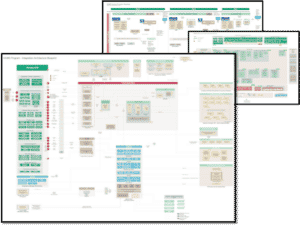Many organisations we work with have been looking to domain-specific cloud-based SaaS solutions to modernise their core ERP business applications. They offer many advantages, including superior functionality, flexibility and usability, as well as the chance to reduce costs and complexity by moving to the cloud. However, they can be more complicated to implement than traditional ERPs due to challenges around data and integration and many program teams underestimate the complexity and impact these two areas will have on their ERP transformation.
In this blog I’ll draw on several experiences consulting on enterprise SaaS ERP transformations to discuss why an integration strategy is so important, how to avoid common missteps, and the key integration approaches you need to work through for a successful implementation.
What does ERP mean today?
Enterprise Resource Planning (ERP) systems have come a long way from their roots 20-30 years ago. Today’s ERP systems serve a key purpose in the enterprise, by integrating and automating essential financial and operational business functions, and providing a single source of insight on data from various sources.
There are two primary deployment models for ERP. On premises ERP software is hosted on private servers and managed by dedicated IT resources. Cloud ERP, a category that includes SaaS, is the fastest growing deployment type according to IDC, and comes with a number of advantages. This category includes recognisable applications like Salesforce CRM, Workday HCM, and Netsuite.
We’ve seen this traction ourselves in the market, having recently worked on several implementations. These were organisations who recognised the complexity of the project early on, and found their projects were much more successful with a sound integration strategy and the right skills to drive it. Below I will refer to these experiences and what was learned in the process to help ensure success.
Why Integration Strategy is Critical for SaaS ERP Implementation
Implementing a new core system today can be more challenging than in the past. This is for a number of reasons, but mostly because of the increasing complexity of business IT landscapes.
Previously, many organisations had their full ERP capability on one vendor/platform or sitting entirely on-premise. Here, the work of an integrator was much more simple. Modernising these core business applications, however, is not about a big bang retirement of all your on-premise systems, or a move to one big new platform. It is an iterative and phased approach, whereby organisations start by carving out domains like HR, Supply Chain or Finance and moving them into the cloud, while retaining the rest of the environment on premise.
In this way, the IT environment becomes a very hybrid environment, with applications and infrastructure on- premise but a lot of new modern application suites sitting in the cloud. Suddenly your integration landscape has changed and become considerably more complex; you need to integrate cloud with cloud-related integration technologies, but the on-premise systems will still have a fencing of integration around them too.
Defining your integration strategy based on your business priorities, use cases and environment is a critical step in dealing with this complexity. Once you’ve chosen to go with a SaaS ERP system, plan how you’re going to integrate around it, and the integration technologies you’ll use for that. There is no one-size-fits-all, and every organisation will have different challenges depending on where they are in their cloud maturity journey. Below I’m going to outline some of the key missteps I’ve seen by organisations in their implementation, and discuss how to plan to avoid them.
Plan to Avoid these Pitfalls
Insufficient Integration Scoping & Planning
I’ve seen many businesses fall short on the integration scoping and planning. In these situations, planning tends to be driven by the new SaaS application, with integration considered only from the new SaaS application’s side. However, it is also critical to consider how integrations outside of the new SaaS (within the existing landscape) will be affected by the implementation. These are often not fully catalogued and hence impact analysis is overlooked. The result is a lot more time and money spent on the implementation than if the full scope of the integration had been planned well from the start.
I recommend giving ample time to analyse the impact on downstream systems, considering the true scope of the project and mapping your existing integration landscape so that you have clarity over how this will need to change with the new SaaS implementation.
Implementing a SaaS ERP? See a sample roadmap, integration blueprint and process map from a recent HCM implementation I worked on here.
Overlooking Data Migration Dependencies for Integration
Data migration and integration interdependencies also tend to be easily overlooked. Unless you’re a greenfield organisation, you need to be planning for data migration. Why am I talking about data migration in an integration blog? Because the data mapping that is used to load the historic data into the new system also has a significant overlap with the data migration for integration.
However, people tend to consider data migration and integration as two separate activities, siloing them into separate teams on the project who don’t talk. I’ve been involved in two large SaaS implementations in the market recently and both of them experienced a big bottleneck around implementation because of data migration issues that weren’t discovered until they got to integration testing. Early collaboration across data migration and integration streams can go a long way towards avoiding these issues late in the program schedule.
All You Need is Out-of-the-Box Integration
A common misconception I’ve encountered is that SaaS ERP implementation is quick and easy due to embedded integration features. Most modern SaaS solutions come with pre-built connectors or templates for popular applications, and vendors emphasise how easily a business can sign up, hook in, and start using their software. This isn’t without merit; these out-of-the-box features/connectors can be very effective in, as put by Gartner, ‘addressing common and repeatable integration use cases’ and/or ‘non differentiating’ scenarios (business processes that are relatively generic across different companies). They can also be particularly useful as time-savers in larger implementation projects, where there are smaller tactical integration needs.
But these features won’t cover the full set of use cases in an enterprise-scale implementation, and they won’t be a best fit for every scenario. Specifically, in the Customer Experience (CX) domain where you have more real-time integration requirements, these connectors may not help. Then there are approaches like event-driven architecture (which my colleague talks about here) – some vendors are mature in their SaaS offering for integration around event-driven, some are not.
There is also the likelihood that you will still have other legacy systems without end points that your new SaaS ERP will need to connect to – here you will need to find alternatives to out-of-the-box integration such as integrating via the front-end with RPA technology. Consider these scenarios before you embark on your implementation, as the integration part may need more attention than you thought.
All You Need is a Best of Breed iPaaS
SaaS ERP implementations are part of a broader cloud enablement strategy in an organisation, which could be driven by factors such as cost reduction and organisation agility. There are different tiers of SaaS ERPs available in the market to suit the need for large organisations vs small to mid-sized organisations. The same model is also applied to iPaaS (Integration Platform as a Service) technology.
When buying an iPaaS, the investment is not a small one. The cost of best-of-breed integration platforms may be hindering the efforts of mid-to-large businesses who could reap the benefits of otherwise-very-affordable SaaS ERP implementation. Purchasing an iPaaS can solve many integration challenges, however choosing the right integration technology that fits an organisation’s environment is critical.
We recently worked with a mid-size not-for-profit organisation that simply did not have the funds or integration volume to justify a Mulesoft or Dell Boomi investment. Instead, we created an effective integration layer using cloud integration services on Microsoft Azure, which filled their integration needs at a much lower cost. These cloud provider ecosystems are becoming a very effective way to build integration solutions that bypass the need for large upfront investments in iPaaS technology (see a comparison of using AWS and Azure for this purpose here).
Integration Platform vs Integration Patterns
When planning integration solutions for SaaS ERPs, know that an integration platform of some kind will play a significant role. But more than a platform, it’s critical to think about what patterns are required for different use-cases. ERP integrations require both data and application integration perspectives. Don’t plan for a solution based on buzzwords – it may make the solution complex and risk the overall success of the ERP program.
Consider the available patterns and validate them across your most important use cases and data domains, whether that be a real-time requirement, batch, overnight, etc. For example, API or event-based integration patterns are popular but they may not always be suitable for your ERP’s integration use-cases. In the HR domain, payroll integration happens every fortnight, and there is no need here for scenarios like event-driven or complex real time integration using APIs – this would be overkill. On the other end of the scale there are scenarios like an ecommerce platform that needs to immediately pass information to the supply chain system for distribution, or even in government when a customer applies for a licence form, they expect a real-time response on that.
You will find that the majority of SaaS integration scenarios can be categorised across four or five common integration patterns. These include APIs, event-driven, batch style and advanced BI and analytics. This article describes this in detail.
All of the discussion above is based on not only the theory, but my observations in real projects. We have been doing large scale ERP integration for many years and have seen many integration technologies come and go, but the above situations still occur and set businesses back from success. Fortunately, we’ve also seen organisations get it right by investing in the integration strategy and planning from the get-go, and appreciating the complexity before they dive in.




